Apple iPad Review
Apple iPad Review
Bigger than Jesus, or just a big iPod touch? We find out.
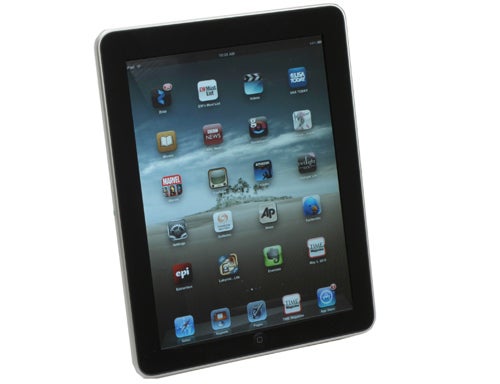
Verdict
Key Specifications
- Review Price: £429.00
- 9.7in, 1024 x 768 pixel LCD screen
- 1GHz single core CPU
- iOS operating system
- Aluminium chassis
Update: Check out our iPad Air and iPad mini 2 Retina
Introduction
It makes a refreshing change to review a product that can’t be pigeon-holed. Apple’s iPad, which has reached levels of mainstream publicity normally reserved for ash clouds and elections, is one such product. It represents the first strike in what could be the defining product segment, if not of 2010, surely of 2011. That Apple is first out of the blocks shows exactly how serious it is about tablets. Apple has already created two epoch defining products in the iPod and the iPhone. Now it’s gunning for a hat-trick.
In comparison to its ambitions the iPad looks almost modest. Fundamentally its design, which is so obviously derived from the iPhone and iPod touch, constitutes little more than the beautifully crafted aluminium casing and the glass fronted screen. This simplicity works, though. Not only is it aesthetically elegant, it’s functionally non-threatening. Aside from a small smattering of buttons, which comprise the iconoic home button, a volume rocker, hold/power button and a switch for locking the screen orientation, the iPad is just a big screen you can touch. No one could ever be intimidated by it.

As it’s the most eye-catching feature, it’s no surprise to find Apple has invested heavily in the quality of the screen. Not only is it very large, measuring 9.7-inches, it has a sharp 1,024 x 768 pixel resolution and utilises the premium LCD panel technology, IPS. This tech, which you’ll find in most of the best LCD TVs, affords excellent viewing angles and deep colours. Combine this with bright LED backlighting and you have a display that showcases videos, photos and magazines extremely well. It’s also just as sensitive and accurate for touch control as its cohorts.
While the screen is the main hardware highlight, also key to the iPad’s success is Apple’s custom-engineered 1GHz system-on-a-chip. Based on CPU tech licensed from British firm ARM and a PowerVR graphics core, it ensures the iPad ticks along at a snappy pace. It’ll also handle 720p h.264 video comfortably, though the aspect of the screen (4:3 as opposed to 16:9) results in large black bars above and below widescreen videos.
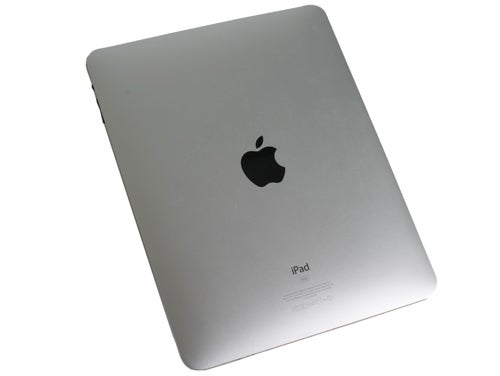
Beyond the processor and screen there isn’t much more to add hardware-wise. Our model, which is a 16GB Wi-Fi only version from the US, does lack 3G and the assisted GPS 3G equipped models enjoy, but that aside it has all the same basic elements. This includes Bluetooth 2.1, Wireless-N Wi-Fi and a digital compass, while storage capacities for all models start at 16GB and go up to 32 and 64GB.
Interface & Native Apps
As the physical design is so similar to that of the iPhone and iPod Touch, it’s no surprise to be greeted by the familiar grid interface. Unlike Apple’s other devices, however, it rotates between portrait and landscape modes. It can also fit more icons: 20 per page, plus up to six docked apps. It would have been easy for Apple to cram even more apps in, but the number is about right – any more and it would look cluttered.
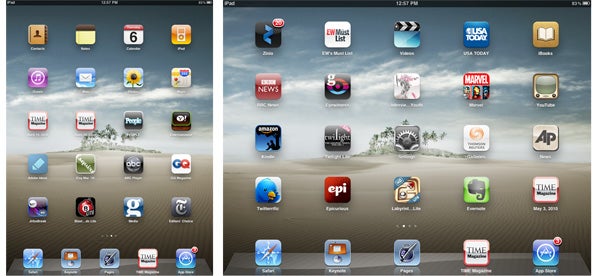
While this grid layout is simplicity itself and plays to the strength of Apple’s burgeoning App Store, it does feel somewhat limiting. If one takes the view that, among its many other functions, the iPad is a very large personal organiser, some kind desktop designed along those lines would be very desirable. It feels like a missed opportunity, especially as the high resolution screen would make creating a more dynamic interface much easier.
Unlike the basic interface, all the pre-installed apps have seen iPad makeovers of varying degrees of severity. One of the best is the Calendar app, which visually resembles an old-style personal organiser. Thanks to the greater resolution of the iPad screen, it’s a really practical, streamlined way of organising your life.
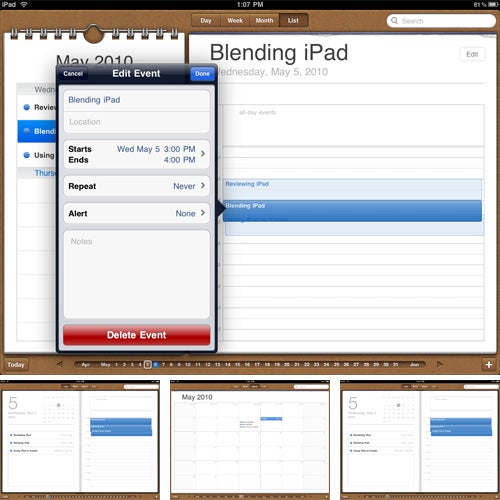
By comparison the Mail app has changed little, but it makes good use of the extra resolution to list your inbox alongside the preview pane when in landscape mode. In portrait it appears as an overlay. Notes has a similarly minor tweak to take advantage of the extra real-estate, but it still feels neglected compared to the other apps.
Google Maps, whose redesign is also largely cosmetic, probably benefits most from the change of format by dint of the screen size and resolution being perfect for navigating maps. You’d look a bit of berk wondering around London trying to find your way around using an iPad, but the hybrid and Street View modes look awesome on the massive screen.
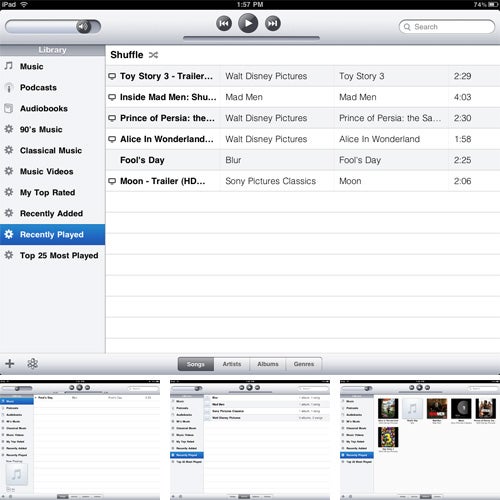
The Videos app still does nothing outstanding beyond showing you the videos you have in a visually appealing way. More fulsome is the revised iPod application, which more than ever resembles a pared down version of iTunes. Its more efficient interface makes it easy to imagine using the iPad, in conjunction with the separately sold dock and a set of speakers, as a kind of living room jukebox.
iBooks & Magazines
Though the native apps are the bread and butter of the iPad, it’s the new iBooks app (and semi-associated interactive magazines) that will ultimately drive the potential success of the iPad. Apple has every intention of making the iPad to books, and publishing as a whole, what the iPod was (and is) to music. Given this fact it seems odd that iBooks isn’t installed as standard, instead it’s a free download from the App Store that comes with a copy of A.A. Milne’s, Winnie-the-Pooh.
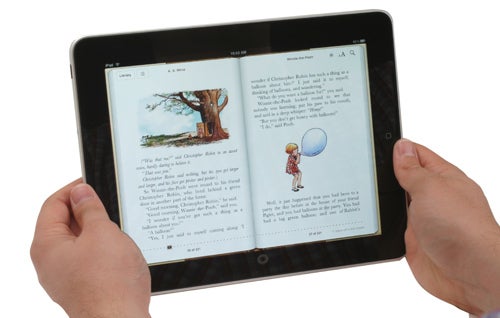
Nonetheless it’s an essential download, as the application itself is simply outstanding. Not only is it visually charming, arranging books into a virtual bookshelf and mimicking the look and feel of a book, it’s packed with attention to detail that makes it a joy to use. Small things, such as the counter that tells you how many pages remain in a chapter, are great touches, as is the ability to quickly look-up dictionary definitions and search Wikipedia and Google straight from the app. Such features add a level of depth and sophistication missing from eBook readers like the Amazon Kindle and the Sony Reader PRS-600 Touch Edition.
Accompanying this is the inevitable iBookstore, which is pretty similar in format to iTunes and the App Store. Buying books is very slickly handled, even allowing for reasonable size samples to be downloaded before you decide to buy. At this point, however, the weakness of the store is its library. Official numbers suggest a catalogue of 60,000 books, of which around half are from the Project Gutenberg free eBook service, but independent assessments suggest the figure is closer to 45,000.
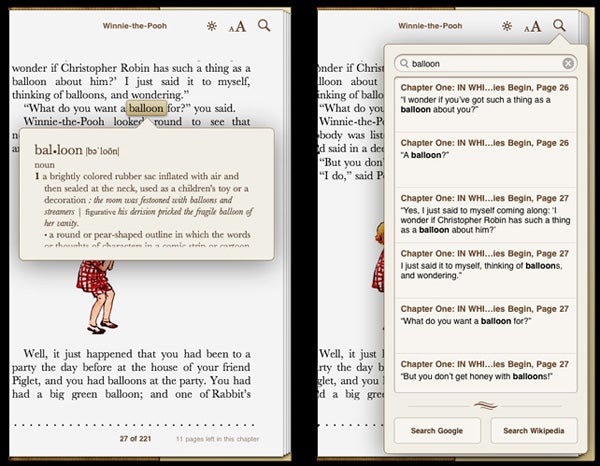
In either case it’s a far cry from the 500,000+ books currently on sale on Amazon’s Kindle store, so Apple has a long way to go before it becomes anything close to comprehensive. Of course Amazon has its own Kindle application for the iPad as well, so it’s not a pure either/or decision, but the Kindle application isn’t anything like as polished and enjoyable as iBooks is.
Another question is whether the iPad is the right kind of device to read books on. Compared to eBook readers and their paper-like displays, it’s difficult to read on the iPad in bright sunlight unless it’s at full brightness, and even then there are reflections and fingerprints to distract you. eBook readers also benefit from battery life that can be measured in days rather than hours, though the iPad doesn’t do too badly itself. Really pummel it and it will still go 10 hours or more before a charge, while more real-world (semi-regular) use should ensure battery life approaching 24, 36 or maybe even 48 hours at a push.
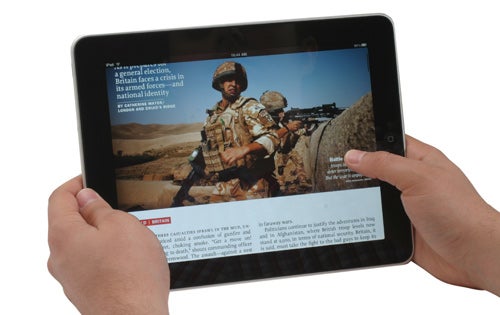
Finally, there’s also the question of eye-strain to contend with, since a backlit LCD will unavoidably put strain on your eyes over a prolonged period. Reading for just an hour or two is unlikely to be a problem, but more prodigious readers (and anyone who’s more sensitive to such issues) may disagree. You’ll want to purchase a case for your iPad, too, since the smooth aluminium back makes it slippery to hold.
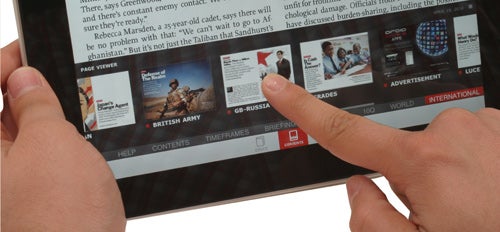
So the jury might still be out for reading books on the iPad, but there’s no doubt that it could herald a whole new lease of life for magazines and newspapers. There are various examples of dedicated apps, such as USA Today, Popular Science and the Zinio viewer app, which demonstrate the potential. By far the best example, though, is Time magazine’s dedicated app. It brings the magazine format into a completely different, interactive light that showcases the potential for media designed specifically for large-format tablets.
iWork Apps & Productivity
While iBooks could be deemed core to the iPad’s proposition, following closely behind are Apple’s mobile versions of its iWork productivity suite: Pages (word processing), Keynote (presentations) and Numbers (spreadsheets). They are essential to Apple’s idea that the iPad isn’t just an enlarged mobile device, but a genuine computing platform.
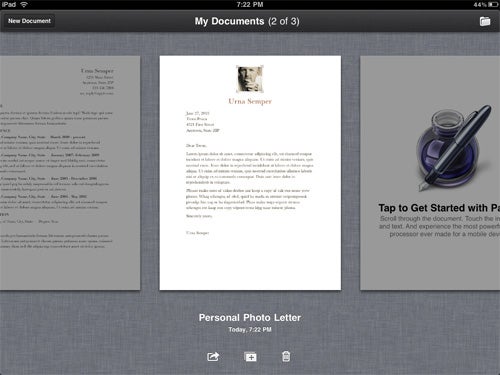
Apple has been successful in this aim, but only to a limited extent. On the whole the three apps are, like iBooks, exceedingly elegant, intuitive and clean applications. Provided your needs are relatively simple and infrequent, at a pinch they might even suffice as your primary port of call for productivity. Likewise, if all you need is to view and make small amendments to already existing documents then they do a job.
There are, however, numerous obstacles in both instances that demonstrate the iPad has a long way to go in this regard. Most fundamental is the patchy reliability of document importing, not only from Microsoft Office docs but also those produced in desktop versions of iWork – where only iWork ’09 is supported!
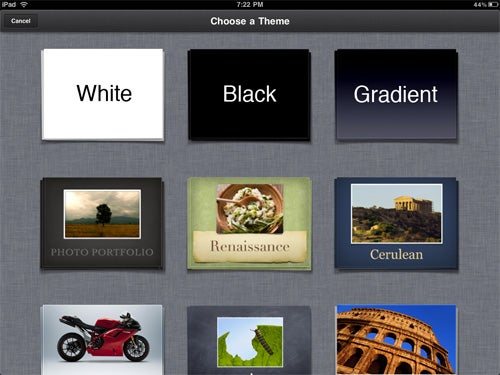
Such issues can often be traced to the limited font support on the iPad, but there are also numerous features that aren’t supported in the mobile versions. One classic example is in Pages, which doesn’t support endnotes or footnotes, while it’s the only one of the three apps that can export to MS Office documents – others must be converted using the desktop versions of the applications! Another irritating omission includes the lack of a presenter view in Keynote, making the iPad largely useless for making serious presentations. Getting documents to and from the iPad is far too laborious an exercise, too, as it’s far too reliant on iTunes and iWork.com
The one saving grace is that typing on the iPad is largely very easy. When held in two hands it might be an inch or so too large to type really quickly, but set it down in landscape mode you can type accurately and at reasonable speed. It’s certainly good enough for the occasional document and regular emails. You can even use a Bluetooth keyboard if you wish, though by that point you may as well get a laptop out and use that instead.
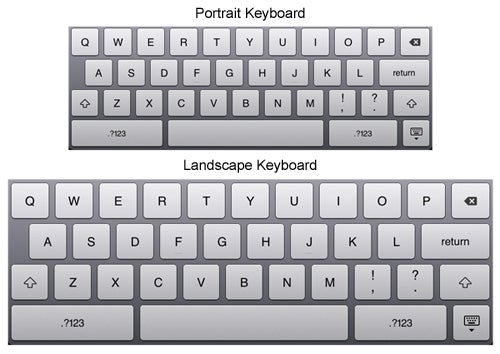
It’s not enough to prevent the great majority finding the iWork apps frustrating experiences, though. They certainly won’t allow you to leave your laptop at home every now again, reinforcing the view that the iPad is stringently a companion device. Ultimately, while they’re fun to use, none of the iWork apps are that practical. Fun may sound like a neat idea, but practicality is what they ought to be about.
Gaming & Problems
While we’ve covered most aspects of the iPad, we should touch briefly on gaming. Since the iPhone has been deemed such a success as a gaming platform, it’s been speculated that the iPad could take this to new heights. It’s possible, especially as the hardware is quite capable, but it’s too early to judge as the market for iPad games is currently dominated by re-tuned iPhone games. At this point in time gaming feels like a nice-to-have, rather than a reason-to-buy, feature. It’ll take something special to persuade us otherwise.

Gaming seems especially trivial given our most substantive complaint about the iPad: you can’t multitask!
To a layman this might seem an odd thing to focus on, but it is a fundamental limitation of the device at this time. On the whole, though it has plenty of issues and uncertainties, the iPad makes a reasonable argument for itself as a companion device. In and around the house, on trains, planes and in other scenarios, an all-in-one device that can play games, watch videos, view photos, read books and magazines, and enjoy all the various internet related activities (e.g. Twitter, Facebook, web apps and websites) makes a good deal of sense – not least as the iPad delivers all these delights very effectively.
However, without multitasking, it rings somewhat hollow. Want to be logged into instant messaging, monitoring Twitter and browsing the Web at the same time? You can’t. Want to stream music from Last.fm or Spotify and read a book at the same time? You can’t. Want to pause a game, check your email and return? Well…you get the idea. Hopefully the multitasking features in iPhone OS 4.0 will make it to the iPad sooner rather than later, but to launch without them seems foolhardy.


There are a few other gripes to be had, too. We can understand the lack of a USB port as it would look pretty ugly on the iPad’s sleek chassis, but not having a memory card reader is a pretty myopic decision. Instead you have to buy a separate adapter for the docking port, which allows you to connect a memory card or USB device (e.g. a digital camera). It’s also frustrating that there’s no mini-HDMI output, or an equivalent, especially as the component video dock has a baffling resolution limit of 576p. Sceptics will also point toward Apple’s limited codec and format support, which remains selective at best.
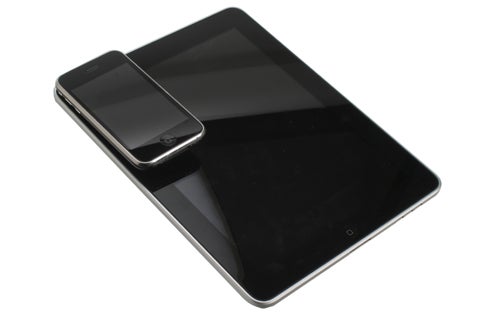
Verdict
There are two conclusions to be made about the Apple iPad. As a product you could buy, it’s a tempting but ultimately unconvincing device. Anyone with a particular penchant for Apple, or enough money to burn and a love of shiny tech, are likely to buy into it. Unlike the iPhone, however, it doesn’t traverse the boundary between early adopters and the mass market. Most people probably wouldn’t know what to do with it.
What it does do is demonstrate the potential of the tablet as a segment. In time, with a few software updates, tweaks to the hardware and a more compelling library of content to draw on, it could well deliver on the hype it currently receives. It’ll also spur on competitors to compete with it, which can only be a good thing.
How we test tablets
We test every tablet we review thoroughly. We use industry standard tests to compare features properly and we use the tablet as our main device over the review period. We’ll always tell you what we find and we never, ever, accept money to review a product.
Trusted Score
Score in detail
-
Performance 8
-
Value 7
-
Design 9
-
Features 7

